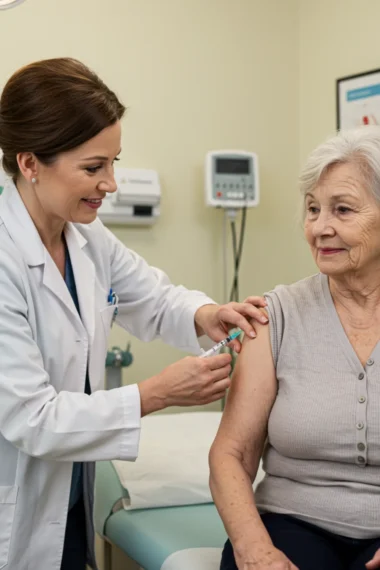Most Common Causes of Death in Elderly
According to the CDC, over 2.1 million Americans aged 65 and older died in 2024, with heart disease, cancer, and Alzheimer’s as the top culprits. Worldwide, these same conditions dominate elderly mortality rates.
Aging isn’t for the faint of heart—literally. As we get older, the body starts showing signs of wear and tear, and some systems just don’t bounce back the way they used to. For those aged 65 and above, the risks of serious health conditions multiply. In fact, according to the CDC, heart disease, cancer, stroke, and Alzheimer’s disease are among the most common causes of death in older adults.
Top 10 Causes of Death in the Elderly
| Rank | Cause of Death | % of Elderly Deaths (U.S., 2022) | Global Impact (WHO) |
|---|---|---|---|
| 1 | Heart Disease | 26.2% | 17.9 million deaths/year |
| 2 | Cancer | 21.1% | 9.3 million elderly deaths |
| 3 | Alzheimer’s Disease | 6.6% | 55 million cases worldwide |
| 4 | Stroke (Cerebrovascular) | 5.7% | 5.5 million deaths/year |
| 5 | Chronic Lower Respiratory Disease (CLRD) | 4.7% | 3.2 million deaths globally |
| 6 | Diabetes | 3.2% | 1.6 million deaths/year |
| 7 | Kidney Disease | 2.1% | 850,000 deaths/year |
| 8 | Influenza & Pneumonia | 1.7% | Major cause in winter |
| 9 | Accidental Falls | 1.6% | Leading injury-related death |
| 10 | Parkinson’s Disease | 1.1% | >10 million cases worldwide |
1. Heart Disease: The Silent and Leading Killer
Heart disease includes coronary artery disease, heart failure, arrhythmias, and more. It causes 1 in every 4 deaths among elderly individuals.
Common Symptoms:
- Chest pain or discomfort
- Fatigue
- Shortness of breath
- Swelling in legs or ankles
Major Risk Factors:
- High blood pressure
- High cholesterol
- Obesity
- Smoking
- Sedentary lifestyle

Prevention Tips:
- Eat heart-healthy foods (leafy greens, nuts, berries)
- Exercise 30 minutes daily
- Manage stress and weight
- Avoid smoking and alcohol
Around 805,000 Americans have a heart attack each year, and 20% are “silent” attacks with no symptoms.
2. Cancer: The Aggressive Second
Cancer becomes more common with age due to weakened immune surveillance and DNA repair mechanisms. Most frequent in elderly: lung, colorectal, prostate (men), and breast (women).
Common Symptoms:
- Unexplained weight loss
- Persistent pain or fatigue
- Changes in bowel habits
- Lumps or unusual bleeding
Risk Factors:
- Smoking, alcohol, radiation
- Family history
- Obesity
- Environmental exposures

Prevention & Early Detection:
- Regular screenings (mammograms, colonoscopies, PSA tests)
- Quit tobacco
- Balanced diet high in antioxidants
60% of cancer cases occur in people aged 65+.
3. Alzheimer’s Disease and Other Dementias
A progressive neurodegenerative disorder that affects memory, behavior, and thinking. It’s the 6th leading cause of death in the U.S.
Early Warning Signs:
- Memory loss disrupting daily life
- Confusion with time or place
- Poor judgment
- Mood and personality changes
Risk Factors:
- Age (most common after 65)
- Genetics (APOE-e4 gene)
- Head trauma
- Lifestyle and heart health
Management:
- No cure yet, but medications (donepezil, memantine) may slow progression
- Cognitive stimulation therapy
- Regular physical and social activity
Women are more likely than men to develop Alzheimer’s.
4. Stroke (Cerebrovascular Disease)
Strokes occur when blood flow to the brain is blocked or reduced. Can cause permanent damage or death within minutes.
Symptoms:
- Sudden numbness or weakness
- Trouble speaking or understanding
- Vision problems
- Severe headache
Risk Factors:
- Hypertension
- Diabetes
- Smoking
- Atrial fibrillation
Prevention:
- Control blood pressure
- Maintain healthy blood sugar
- Avoid salt and high-fat foods
- Immediate use of “clot busters” (tPA) within 3 hours of symptoms
F.A.S.T. = Face drooping, Arm weakness, Speech difficulty, Time to call 911
More Opportunities: CVS Senior Discount Day
5. Chronic Lower Respiratory Disease (COPD)
Includes chronic bronchitis and emphysema, mostly due to long-term exposure to lung irritants like cigarette smoke.
Symptoms:
- Chronic cough
- Shortness of breath
- Wheezing
- Frequent respiratory infections
Risk Factors:
- Smoking (80% of COPD deaths)
- Long-term exposure to air pollutants
- History of asthma
Management:
- Inhalers, bronchodilators
- Oxygen therapy
- Pulmonary rehab
16.4 million Americans have been diagnosed with COPD.
6. Diabetes Mellitus
A metabolic disorder that causes high blood sugar due to insulin resistance or deficiency.
Key Symptoms:
- Frequent urination
- Extreme thirst and hunger
- Fatigue
- Blurred vision
Risk Factors:
- Obesity
- Inactivity
- High blood pressure
- Family history
Prevention & Control:
- Low-carb, high-fiber diet
- Regular blood sugar monitoring
- Oral medications or insulin
29% of Americans aged 65+ have diabetes.
7. Chronic Kidney Disease (CKD)
Gradual loss of kidney function. Can lead to end-stage renal disease requiring dialysis or transplant.
Symptoms:
- Fatigue
- Swelling in feet and ankles
- Nausea
- Difficulty concentrating
Risk Factors:
- Diabetes
- High blood pressure
- Recurrent kidney infections
Management:
- Monitor creatinine and GFR
- Reduce salt and protein intake
- Avoid nephrotoxic drugs
8. Influenza and Pneumonia
These respiratory infections are often underestimated but cause severe complications in older adults, especially during winter.
Symptoms:
- Fever, chills
- Cough
- Chest pain
- Shortness of breath
Risk Factors:
- Age 65+
- Weakened immune system
- Chronic lung or heart disease
Prevention:
- Annual flu shots
- Pneumococcal vaccine every 5 years
- Avoid crowded places during flu season
70%-90% of flu deaths occur in people over 65.
9. Accidental Falls and Injuries
Falls are the leading cause of injury-related deaths in older adults, and they often lead to hip fractures or traumatic brain injury.
Risk Factors:
- Poor vision
- Muscle weakness
- Medications causing dizziness
- Uneven surfaces
Prevention:
- Balance exercises (tai chi)
- Remove tripping hazards
- Use grab bars and non-slip mats
1 in 4 Americans aged 65+ falls each year.
10. Parkinson’s Disease
A chronic, progressive movement disorder affecting dopamine-producing neurons in the brain.
Key Symptoms:
- Tremors
- Slowness of movement
- Muscle stiffness
- Balance issues
Risk Factors:
- Age (average onset: 60)
- Genetics
- Exposure to toxins
Management:
- Medications (Levodopa)
- Physical therapy
- Deep brain stimulation (for advanced cases)
How to Improve Elderly Health and Longevity?
Here are 7 practical ways to reduce the risk of these deadly conditions:
- Regular Health Screenings
- Stay Physically Active
- Eat a Balanced Diet
- Take Medications as Prescribed
- Avoid Smoking & Limit Alcohol
- Manage Stress Levels
- Stay Socially Engaged
Wrapping It All Up
Aging might be a fact of life, but dying early from preventable conditions doesn’t have to be. With proactive care, education, and lifestyle changes, older adults can significantly increase not just their lifespan—but their health span. Whether you’re caring for an elderly loved one or looking ahead to your own golden years, knowing the risks is the first step to reducing them.
FAQs
Can elderly people live longer with chronic illnesses?
Yes, with proper care, many chronic illnesses like diabetes or heart disease can be managed effectively, extending both lifespan and quality of life.
What is the average life expectancy today?
In the U.S., the average life expectancy is around 76.4 years, but many individuals live well into their 80s and 90s.
What causes sudden death in elderly people?
Common causes include cardiac arrest, stroke, or pulmonary embolism. Regular checkups can detect early warning signs.










